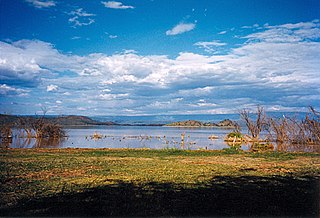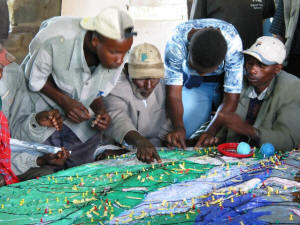
The Maasai are a Nilotic ethnic group inhabiting northern, central and southern Kenya and northern Tanzania, near the African Great Lakes region. Their native language is the Maasai language, a Nilotic language related to Dinka, Kalenjin and Nuer. Except for some elders living in rural areas, most Maasai people speak the official languages of Kenya and Tanzania—Swahili and English.

Lake Baringo is, after Lake Turkana, the most northern of the Kenyan Rift Valley lakes, with a surface area of 130 square kilometres (50 sq mi) and an elevation of 970 metres (3,180 ft). The lake is fed by several rivers: the Molo, Perkerra and Ol Arabel. It has no obvious outlet; the waters are assumed to seep through lake sediments into the faulted volcanic bedrock. It is one of the two freshwater lakes in the Rift Valley in Kenya, the other being Lake Naivasha.
The Nilotic people are people indigenous to the South Sudan and the East Africa who speak the Nilotic languages. They inhabit South Sudan and the Gambela Region of Ethiopia, while also being a large minority in Kenya, Uganda, the north eastern border area of Democratic Republic of the Congo, and Tanzania. The Nilotic peoples consist of the Dinka, the Nuer, the Shilluk, the Luo peoples, the Alur, the Anuak, the Ateker peoples, the Kalenjin people and the Karamojong people also known as the Karamojong or Karimojong,Chaga people, Ngasa people, Datooga, Samburu, and the Maa-speaking peoples.

The Samburu are a Nilotic people of north-central Kenya. Traditionally, they are semi-nomadic pastoralists who primarily herd cattle but also keep sheep, goats and camels. They refer to themselves as Lokop or Loikop, a term with varied interpretations among the Samburu. Some believe it means "owners of the land" while others have different interpretations.
The Eastern Nilotic languages are one of the three primary branches of the Nilotic languages, themselves belonging to the Eastern Sudanic subfamily of Nilo-Saharan; they are believed to have begun to diverge about 3,000 years ago, and have spread southwards from an original home in Equatoria in South Sudan. They are spoken across a large area in East Africa, ranging from Equatoria to the highlands of Tanzania. Their speakers are mostly cattle herders living in semi-arid or arid plains.
Dorobo is a derogatory umbrella term for several unrelated hunter-gatherer groups of Kenya and Tanzania. They comprised client groups to the Maasai and did not practice cattle pastoralism.
Pökoot is a language spoken in western Kenya and eastern Uganda by the Pokot people. Pökoot is classified to the northern branch of the Kalenjin languages found in Kenya, Uganda, and Tanzania. The Pökoot are usually called "Kimukon" by the other Kalenjin peoples. A 1994 figure of SIL puts the total number of speakers at 264,000, while the only slightly more recent Schladt (1997:40) gives the more conservative estimate of 150,000 people, presumably based on the figures found in Rottland (1982:26) who puts the number at slightly more than 115,000.

Ogiek is a Southern Nilotic language of the Kalenjin family spoken or once spoken by the Ogiek peoples, scattered groups of hunter-gatherers in Southern Kenya and Northern Tanzania. Most Ogiek speakers have assimilated to cultures of surrounding peoples: the Akie in northern Tanzania now speak Maasai and the Ogiek of Kinare, Kenya now speak Gikuyu. Ndorobo is a term considered derogatory, occasionally used to refer to various groups of hunter-gatherers in this area, including the Ogiek.

Maasai or Maa is an Eastern Nilotic language spoken in Southern Kenya and Northern Tanzania by the Maasai people, numbering about 1.5 million. It is closely related to the other Maa varieties: Samburu, the language of the Samburu people of central Kenya, Chamus, spoken south and southeast of Lake Baringo ; and Parakuyu of Tanzania. The Maasai, Samburu, il-Chamus and Parakuyu peoples are historically related and all refer to their language as ɔl Maa. Properly speaking, "Maa" refers to the language and the culture and "Maasai" refers to the people "who speak Maa".
The Maa languages are a group of closely related Eastern Nilotic languages spoken in parts of Kenya and Tanzania by more than a million speakers. They are subdivided into North and South Maa. The Maa languages are related to the Lotuko languages spoken in South Sudan.
Samburu is a Maa language dialect spoken by Samburu pastoralists in northern Kenya. The Samburu number about 128,000. The Samburu dialect is closely related to the Camus dialect and to the South Maasai dialects. The word "Samburu" itself may derive from the Maa word saamburr for a leather bag the Samburu use.
Ongamo, or Ngas, is an extinct Eastern Nilotic language of Tanzania. It is closely related to the Maa languages, but more distantly than they are to each other. Ongamo has 60% of lexical similarity with Maasai, Samburu, and Camus. Speakers have shifted to Chagga, a dominant regional Bantu language.

The Okiek, sometimes called the Ogiek or Akiek, are a Southern Nilotic ethnic group native to Tanzania and Southern Kenya, and Western Kenya. In 2019 the ethnic Okiek population was 52,596, although the number of those speaking the Akiek language was as low as 500.
El Molo is a possibly extinct language belonging to the Cushitic branch of the Afro-Asiatic language family. It was spoken by the El Molo people on the southeastern shore of Lake Turkana, in northern Kenya. Alternate names to El Molo are Dehes, Elmolo, Fura-Pawa, and Ldes. It was thought to be extinct in the middle part of the 20th century, but a few speakers were found in the later 20th century. Most of the El Molo population have shifted to the neighboring Samburu language. El Molo also has no known dialects but it is similar to Daasanach.
The Loikop people, also known as Wakuafi, Kor, Mu-Oko, Muoko/Ma-Uoko and Mwoko, were a tribal confederacy who inhabited present-day Kenya in the regions north and west of Mount Kenya and east and south of Lake Turkana. The area is roughly conterminous with Samburu and Laikipia Counties and portions of Baringo, Turkana and (possibly) Meru Counties. The group spoke a common tongue related to the Maasai language, and typically herded cattle. The Loikop occasionally interacted with the Cushitic, Bantu, and Chok peoples. The confederacy had dispersed by the 21st century.
The Chok were a society that lived on the Elgeyo Escarpment in Kenya.
The Maliri were a people, recalled by various communities in Kenya and Uganda today, that inhabited regions on the north east of and north west borders of Uganda and Kenya respectively and later spread to regions in southern Ethiopia.
Mutai is a term used by the Maa-speaking communities of Kenya to describe a period of wars, usually triggered by disease and/or drought affecting widespread areas of the Rift Valley region of Kenya. According to Samburu and Maasai tradition, two periods of Mutai occurred during the nineteenth century. The second Mutai lasted from the 1870s to the 1890s.
Mutai is a term used by the Maa-speaking communities of Kenya to describe a period of wars, usually triggered by disease and/or drought and affecting widespread areas of the Rift Valley region of Kenya. According to Samburu and Maasai folklore, periods of Mutai occurred during the nineteenth century.
The Laikipiak people were a community that inhabited the plateau located on the eastern escarpment of the Rift Valley in Kenya that today bears their name. They are said to have arisen from the scattering of the Kwavi by the Maasai in the 1830s.They were one of two significant sections of that community that stayed together. The other being the Uasin Gishu with whom they would later ally against the Maasai. Many Maa-speakers in Laikipia County today claim Laikipiak ancestry, namely those among the Ilng'wesi, Ildigirri and Ilmumonyot sub-sections of the Laikipia Maasai.





